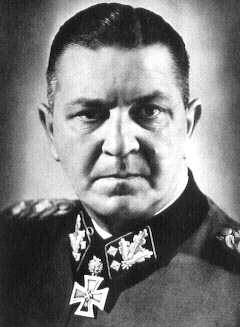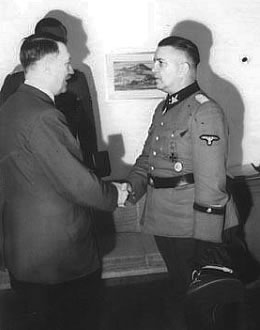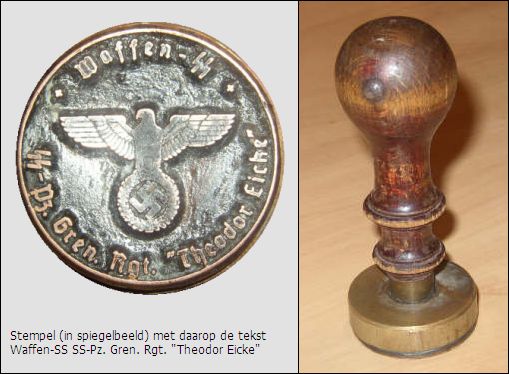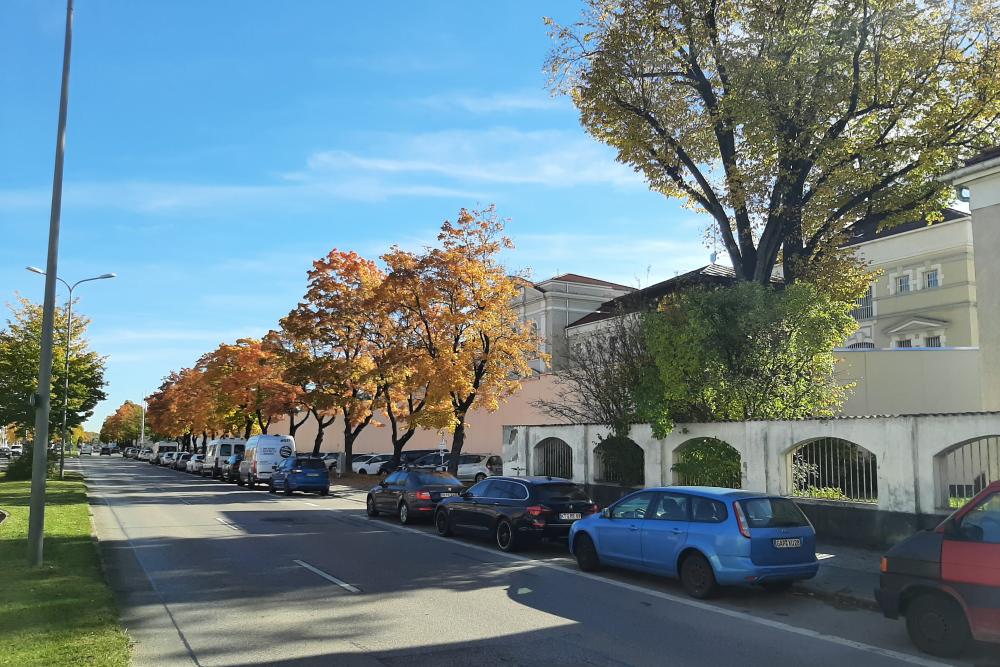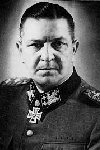Lost youth and failed career
Theodor Eicke was born October 17, 1892 in Hüdingen in the German federal state of Lotharingen. He was the youngest of 11 children and his father, Heinrich Eicke, was a station master. After primary school he attended secondary school in Hampont. Theodor was not a good pupil, he did not finish school and exchanged the school benches for the army. In 1909, he started his career in the German Imperial Army. During the First World War he served as paymaster on the western front and was awarded the EK 2 (Iron Cross 2nd class).
To Eicke, just like to many other Germans, the defeat of his country was very hard to swallow. Eicke considered the Treaty of Versailles an insult to the German population and he became a fervent opponent of the Weimar Republic. His disgust of the Weimar Republic and the Treaty of Versailles would have an enormous impact on Eicke’s future life.
Eicke married Bertha Schwebel December 26, 1914. Their daughter Irma was born April 5, 1916 and four years later, on May 4, his son Hermann was born; he died December 2, 1941 at the front.
March 1, 1939, Eicke entered technical school in Ilmenau but in September that year he was expelled for financial reasons and his radical political ideas. Eicke decided to embark on a career in the police, he applied as a candidate in Ilmenau but he was excluded for his anti-republican feelings. Yet, in September 1920, he passed his Schutzpolizei exam in Cottbus but he was not admitted to the police force because of his political activities. In Weimar, he was appointed candidate-agent but after two weeks in service he was fired. In the end, in Ludwigshafen an Rhein, he was given a job as police administrator. In 1923 he was fired again for political reasons. From then on, a further career for Eicke within the police was out of the question.
From January 1923 until March 1932, Eicke worked for IG Farben, initially as commercial assistant, later as security advisor. Meanwhile, Eicke had joined the N.S.D.A.P. on December 1, 1928 and he was active within the SA. June 29, 1930, he joined the SS where his qualities as a leader were soon noticed. His violent political activities were the reason for his discharge from IG Farben. In the same year he was sentenced in absentia for complicity in a series of political murder attempts and illegal possession of arms. Following the advice of Heinrich Himmler, he fled to northern Italy, returning in 1933 when Hitler had risen to power. The Weimar republic was a thing of the past and Eicke hoped to make a contribution to the restoration of the glory of his beloved fatherland under Nazi rule.
Appointed camp commander
The same man who had advised Eicke to flee to Italy, Heinrich Himmler, now had special intentions with him. But before Himmler could make use of Eicke’s services, he had to get him out of a psychiatric institution first. Following a personal feud with Gauleiter Bürckel, Eicke was admitted to a psychiatric clinic in Würzburg for observation. He was locked up there for violent conduct and misbehavior but mostly because he had been in charge of a revolt by the SS in the Gau of the Gauleiter of Würzburg. Himmler’s authority was already far-reaching in 1933 and he could get Eicke released.
Himmler needed Eicke to take charge in concentration camp Dachau, 10 miles north of Munich. Dachau was the first Nazi concentration camp and was opened on March 22, 1933. Initially the regional police was in charge of the camp but on April 2, 1933, Heinrich Himmler’s SS took charge. The first inmates of the camp were 5,000 Communists and socialdemocrats but soon, Jews and Gypsies ended up in the camp as well. It was initially intended to have the prisoners in Dachau follow a social re-integration course. During the day, the inmates were put to work cultivating the swamp in Dachau and after work, lectures about popular-religious art would be delivered. The aim was to make the inmates suitable for Nazi society.
As prisoners were very seldom released from the camp, social re-integration turned out not to be an important purpose of the camp. The main purpose was locking up political prisoners in order to safeguard the Nazi regime. In the camp, the inmates were subjected to torture by SS guards commanded by SS-Obersturmführer Hilmar Wäckerle. Killing prisoners was a daily routine, to the great dissatisfaction of the Bavarian government which charged Wäckerle with murder. Himmler decided to replace Wäckerle by Eicke in order to bring order into the chaos.
Himmler appointed Eicke camp commander of Dachau on January 26, 1933. He considered him the ideal person to reorganize Dachau because of his obedience to authority, his great talent of organization and his capacity to motivate people and make then subordinate to himself. Moreover, Eicke was a very fanatic Nazi and he fostered hate towards non-German parts of the German society. In the camp, Eicke was soon known as Papa Eicke and his guards as Papa Eicke’s boys. Together they made up a gang of murderers.
During his tenure as camp commander, Eicke established a policy which would henceforth be applied to all concentration camps in Germany. Eicke was the instigator of the "disciplinary and penal measures for a prison camp" and the "regulations for guides and guards of prisoners." A quote from these regulations prove his cruelty: "He who talks about politics with rebellious intent, assembles with others or distributes horror propaganda of the enemy will be hanged, according to revolutionary law; he who attacks a guard, disobeys an order or incriminates himself in any other way will be executed on the spot or hanged later." In addition, Eicke introduced lesser punishments as well: penal exercise, beatings by cudgel, withholding mail, withholding food, a hard wooden bunk, a reprimand or a warning. Under the slogan "Tolerance makes weak," Eicke taught his SS men to act ruthlessly against enemies of the fatherland.
Night of the Long Knives
The night of June 30, 1934 has entered history as the Night of the Long Knives. By order of Hitler, the top of the SA had to be eliminated as the vast power of the SA constituted a threat to his own power and the continuing existence of Nazi rule. In this night, many high ranking members of the SA were murdered by SS men. The leader of the SA, Ernst Röhm, was arrested and locked up in a cell in Stadelheim prison in Munich. Hitler wanted Röhm to commit suicide there. In doing so, he would admit to the German population he had made a grave mistake by planning a Putsch.
July 1, 1934, Eicke, his deputy SS-Sturmführer Michael Lippert and a third SS man were ordered to go to Stadelheim prison. There they left Röhm alone in his cell with a pistol containing one bullet and a special edition of the German newspaper Der Völkische Beobachter. This paper contained the latest news about the Putsch against the Hitler regime Röhm had allegedly been planning. Should Röhm commit suicide, he would be spared execution but after 10 minutes, Eicke and his colleagues had not heard a shot. Eicke and Lippert returned to Röhm in his cell and together they executed him.
In the Night of the Long Knives, various former opponents of the N.S.D.A.P. and of Hitler were arrested, among them 71-year-old Gustav Ritter von Kahr for his resistance during the Hitler Putsch of 1923. He was tortured and shot in Dachau on Eicke’s orders. His body was later found in the swamp, hacked to pieces with a pickaxe.
The Dachau school
June 20, 1934, Eicke was transferred to Himmler’s staff for his eminent service record and his involvement in the Night of the Long Knives and subsequently, the Reichsführer-SS appointed him Inspektor der Konzentrationslager (inspector of concentration camps) on July 7. On June 11, he had already been promoted to SS-Gruppenführer. In his capacity as inspector, Eicke worked under Himmler’s direct supervision but actually he had exclusive authority over the organization within the camps. Reinhard Heydrich (Bio Heydrich) saw to the delivery of prisoners and he could decide on release of prisoners but within the confines of the camps, even he had less authority than Eicke. The latter reorganized and centralized the system of the concentration camps. Dachau, Buchenwald, Flossenburg, Mauthausen and Ravensbrück became the focal points of terror. Eicke also invented various methods of torture within the camps and he introduced the striped uniforms for inmates.
In 1934, Eicke unified all camp guards in a special unit within the SS: the Totenkopfverbände (death head units). The unit was given this name after the badge, showing a skull and crossbones the men wore on the collar of their uniforms. Just like in Dachau, Eicke taught his men not to show any weakness or pity. According to Eicke, guards of concentration camps were chosen to save the people as bearers of the Nazi revolution. Eicke had the members of the Totenkopfverbände know they belonged to the upper class and in this way he created a sense of superiority and togetherness. Eicke’s policy was very successful as his SS men were soon feared by friend and foe alike.
The concentration camp in Dachau continued to serve as a model camp for the other German camps. The "Dachau school" was the training ground for the many men who would sculpt the Holocaust. Rudolph Höss (Bio Höss) was appointed commander of KZ Auschwitz, Max Kögel of KZ Majdanek and Adolph Eichmann (Bio Eichmann) became one of the most important organizers of the Holocaust within the Reichssicherheitshauptamt (R.S.H.A., Head Office of State Security).
Totenkopfverbände
From 1939 onwards, members of the Totenkopfverbände were also deployed at the front. Within the SS, the SS-Verfügungstruppen (SS-VT, reserve) were already specialized in military sense and trained, moreover, they were militarily active at home and abroad. This way, the SS-Division Totenkopf emerged and became part of the Waffen-SS, the military branch of the SS which was deployed at the front just like the Wehrmacht. The cruelty the men had been taught in the camps also emerged at the front, the unit was responsible for various war crimes including executions and murdering Jews and Soviet citizens. In the concentration camps, the guards who served in the SS-Division Totenkopf were replaced by older members of the Allgemeine SS, less suitable for military service.
Eicke was in command of the SS-Division Totenkopf from November 14, 1939 to July 6, 1941. That day he was injured however when his staff car hit a mine. His right foot was injured and he suffered from nerve damage. Matthias Kleinheisterkamp and Georg Keppler replaced him for the time being but in September 1941, he returned as commander of the division which meanwhile had been upgraded to SS-Panzer-Grenadier-Totenkopf Division. The same month, Eicke was promoted to SS-Gruppenführer und Generalleutnant der Waffen-SS. April 20, 1942 he received his last promotion, this time to SS-Obergruppenführer und General der Waffen-SS.
In 1941, 17,000 soldiers still fought within the SS-Panzer-Grenadier-Totenkopf Division, commanded by Eicke; until March, 12,000 men were killed and in October that year, the division was forced to withdraw from the Soviet Union to regroup. Moreover, from that year onwards, Eicke’s men could also be posted to other divisions than the SS-Panzer-Grenadier-Totenkopf Division and the feeling of superiority disappeared. On February 26, 1943, Eicke lost his life when his plane was shot down in the vicinity of Orelka in Russia.
Definitielijst
- Allgemeine SS
- “General SS”. The civilian branch of the Schutzstaffel (SS). Since 1939 the counterpart of the Allgemeine-SS was the Waffen-SS, (the military branch of the SS). The Allgemeine-SS was the backbone of the organisation and the source for recruiting the men for the Waffen-SS, the SD (Sicherheitsdienst) and the Totenkopfverbände. During the war years the Allgemeine-SS was involved in amongst others in local politics and administrative and government business.
- concentration camp
- Closed camp where people are being held captive that are considered to be anti- social, enemies of the state, criminal or unwanted individuals. These groups mostly do not get a fair trial or are condemned to doing time in a camp.
- Dachau
- City in the German state of Bavaria where the Nazis established their first concentration camp.
- First World War
- Took place from 1914 till 1918 and is also named The Great War. The conflict started because of increased nationalism, militarism and neo-colonialism in Europe. Two alliances battled one another during the 4-year war, which after a dynamic start, resulted into static trench warfare. The belligerents were the Triple Alliance (consisting of Great-Britain, France, and Russia; later enlarged by Italy and the USA, amongst others) on the one hand and the Central Powers (consisting of Germany, Austria-Hungary, Bulgaria and the Ottoman empire) on the other hand. The war was characterized by the huge number of casualties and the use of many new weapons (flamethrowers, aircraft, poison gas, tanks). The war ended in 1918 when Germany and its allies surrendered unconditionally.
- Gau
- “Shire”. District in the Third Reich established by the NSDAP.
- Gauleiter
- Leader and representative of the NSDAP of a Gau.
- Hitler Putsch
- An attempted coup d’état by the NSDAP mainly carried out by the SA in Munich on 8 and 9 November 1923 . It failed and Hitler was sentenced to five years in prison.
- Holocaust
- Term for the destruction of European Jewry by the Nazis. Holokauston is the Greek term for a completely burnt sacrifice.
- Iron Cross
- English translation of the German decoration Eisernes Kreuz.
- Jews
- Middle Eastern people with own religion that lived in Palestine. They distinguished themselves by their strong monotheism and the strict observance of the Law and tradition. During World War 2 the Jewish people were ruthlessly persecuted and annihilated by the German Nazis. . An estimated 6,000,000 Jews were exterminated.
- Mauthausen
- Place in Austria where the Nazi’s established a concentration camp from 1938 to 1945.
- mine
- An object filled with explosives, equipped with detonator which is activated by either remote control or by colliding with the targeted object. Mines are intended to destroy of damage vehicles, aircrafts or vessels, or to injure, kill or otherwise putting staff out of action. It is also possible to deny enemy access of a specific area by laying mines.
- Nazi
- Abbreviation of a national socialist.
- Night of the Long Knives
- Night of 30 June to 1 July 1933 during which Hitler killed many of the demanding leaders of the SA, including Ernst Röhm.
- propaganda
- Often misleading information used to gain support among supporters or to gain support. Often used to accomplish ideas and political goals.
- Putsch
- Coup, often involving the use of violence.
- resistance
- Resistance against the enemy. Often also with armed resources.
- revolution
- Usually sudden and violent reversal of existing (political) the political set-up and situations.
- Soviet Union
- Soviet Russia, alternative name for the USSR.
- Totenkopf
- “Death’s head”. Symbol that was used by the SS. Also the name of an SS Division.
- Totenkopfverbände
- Death’s head regiments. Special formation inside the Schutzstaffel (SS) that was deployed to guard concentration camps.
- Waffen-SS
- Name of Military section of the SS.
- war crimes
- Crimes committed in wartime. Often concerning crimes committed by soldiers against civilians.
- Wehrmacht
- German armed military forces, divided in ground forces, air force and navy.
- Weimar Republic
- Name for the German republic from 1919 until 1933. Hitler ended the Weimar republic and founded the Third Reich.
- Würzburg
- German short range radar. Was used to guide searchlights, FLAK and guiding German night fighters.
Images
Information
- Article by:
- Kevin Prenger
- Translated by:
- Arnold Palthe
- Published on:
- 19-01-2025
- Feedback?
- Send it!
Related sights
Sources
- KERSHAW, I., Hitler - Hoogmoed 1889-1936, Het Spectrum, Utrecht, 2003.
- KNOPP, G., Hitlers moordenaars, Het Spectrum, Utrecht, 2004.
- READ, A., Discipelen van de duivel, Balans, Amsterdam, 2004.
- SPECTOR, S. & ROZETT, R., Encyclopedie van de Holocaust, Kok, Kampen, 2004.
- Axis Biographical Research
- Axis History
- Shoa.de
- Nederlanders in de Waffen SS
